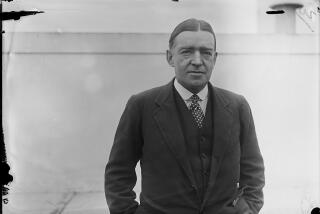Divers to Seek Revolutionary War Relics
- Share via
BANGOR, Maine — If Paul Revere ever shouted “The British are coming!” in this neck of the woods, it most likely happened during a moment of panic in 1779, when he turned tail and ran. And if the fleeing patriot left anything behind, it may yet be awaiting rescue at the bottom of the murky Penobscot River.
That’s what underwater archeologist Warren Riess and a bunch of local historians are hoping. They recently began planning to search in earnest for such artifacts, although the items would be a reminder of one of the worst disasters in U.S. naval history.
The debacle was called the Penobscot Expedition, and not until Pearl Harbor in 1941 were its losses eclipsed. That’s probably why it almost never shows up in textbook accounts of the American Revolution.
Launched as an amphibious attack on a British fort by 40 American ships and boats, it proceeded so timidly that a British fleet had time to sail to the rescue, chasing the invasion force up the Penobscot River. Every last American craft was either scuttled, captured or burned. Nearly 500 men were killed or captured. About 1,500 others--including Revere, the expedition’s artillery commander--fled ashore into the bug-infested woods of Maine for a long, ignominious retreat to Boston.
“The salvage diving started within weeks of the battle itself,” says local historian John Cayford, who wrote a book on the expedition. But that was the work of the victorious British, who not only held onto their fort but hauled nearly 100 abandoned cannon out of the water, shipping them north to Halifax, Nova Scotia, to arm unprotected merchant ships against American privateers.
Now, 220 years later, it is the locals’ turn to retrieve some of the booty.
The state has allocated $15,000 for the project and survey dives in August turned up a cannonball, grapeshot, some broken ceramics and a brass buckle.
Riess, an underwater archeologist with the University of Maine’s Darling Marine Center, has been trying for about 20 years to stir interest in such a project. He worked earlier on the excavation of some of the expedition ships scuttled at the mouth of the river in Penobscot Bay. Recently he has shifted his attention toward the river, particularly the section flowing between the towns of Bangor and Brewer.
Cayford, the author, got interested in 1953. “I was working as a diver when they were building the Joshua L. Chamberlain bridge (between Bangor and Brewer),” he says. “We were excavating for a cofferdam. You were lucky to be able to see your hand in front of your face from all the crap dumped in [the river] by seven mills and the towns upstream.”
But he remembers the moment that he looked up and saw a large shape pass through a beam of sunlight as it was hauled toward the surface. “It looked like a hunk of pulp wood,” he says. “It was a cannon. We brought up five of them. They were four-pounders.”
They were made of bronze, each with the seal of Massachusetts, and they had been cast by Revere’s works in Boston in 1778. Cayford had to find out more.
“So, I started digging into the situation, and in 1957 I found out why nobody had ever heard of the Penobscot Expedition. It was because it was such a disgraceful defeat.”
More to Read
Sign up for Essential California
The most important California stories and recommendations in your inbox every morning.
You may occasionally receive promotional content from the Los Angeles Times.













